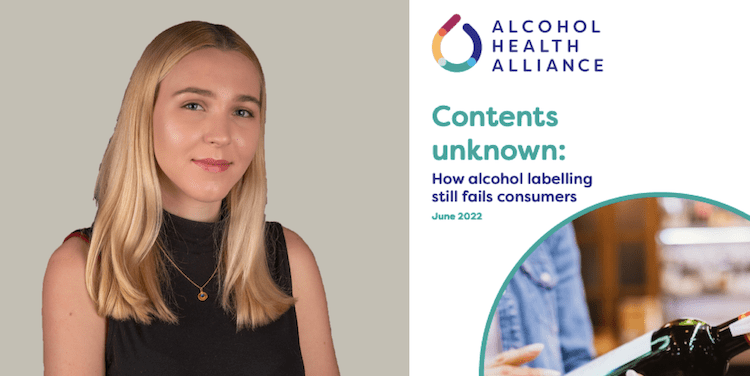
The Alcohol Health Alliance’s (AHA) latest report shines a light on just how much the alcohol industry is keeping consumers in the dark about what they are drinking.
Like me, you might find it shocking to learn that while all other food and drink products are required to display information like ingredients, nutritional values and sugar content on their labels, alcohol product labels are exempt from these rules.
This means that what goes on the labels – other than the mandatory information about the product’s volume, strength and allergens – is up to the alcohol producers themselves.
Our new report Contents unknown: How alcohol labelling still fails consumers analysed 369 alcohol labels to see what the industry is – and isn’t – displaying on their labels. As you might guess from its title, the picture isn’t great.
Do you know what you are drinking?
If I want to know what is in a packet of crisps or a can of lemonade before I buy it, the information is right there at my fingertips on the packaging I’m holding. This is not the case with most alcoholic products – we found that just 20% of alcohol products listed the full ingredients. This begs the question: do we even know what we are drinking?
Furthermore, alcohol accounts for nearly 10% of a drinker’s daily calorie intake. Yet we found that just two in five alcohol labels displayed the drink’s calorie content. Only 6% included sugar content and merely 5% included full nutritional information.
Without this information available, consumers could unwittingly be upping their daily sugar and calorie intake. This can lead to an increased risk of health conditions such as type-2 diabetes, obesity and tooth decay.
Why does this matter? Well, it is our right to know what exactly is going into our bodies. What we eat and drink impacts our health, and we should have the information in hand to help us make decisions. Yet, as an overwhelming majority of alcoholic drinks aren’t displaying this information, what should be an informed decision ends up being watered down to a guess instead.
Do you know the dangers of drinking?
Alcohol is a harmful substance. However, people often don’t know the specifics of the harm alcohol causes. For example, alcohol is causally linked with seven types of cancer, including breast, mouth and liver cancer. In fact, 46 new cancer cases a day in the UK in 2020 were linked to alcohol consumption.
But most people in the UK aren’t aware of these risks. Polling has shown that just a quarter of people know that alcohol causes breast cancer in women. Moreover, a third of people are unaware that it is safest not to drink at all in pregnancy.
Alcohol labels are an effective and easy tool for informing consumers about these matters by increasing knowledge of the health risks and potentially prompting behaviour change. A recent systematic review analysing the evidence around enhanced alcohol labels concluded that labels with health messages, unit information and drinking guidelines improve consumer knowledge of health and safety risks.
Including these elements is also widely supported by the public: 70% of surveyed adults supported a health warning and 55% supported a specific cancer warning.
Yet, we found that just 10 product labels included a general health warning and only 1 included a specific cancer warning.
What can we do?
The results of our report show that the alcohol industry prefers to keep consumers in the dark. With alcohol harm rates at an all-time high, we need urgent action.
The Government promised to consult on alcohol labelling in 2020, but two years later we are still waiting for the consultation to be published.
If you think we have the right to know what’s in our drink, email your MP our report and let them know why better alcohol labelling and alcohol harm reduction matter to you.
Written by Anu Rumm, Policy and Advocacy Officer, Alcohol Health Alliance.
All IAS Blogposts are published with the permission of the author. The views expressed are solely the author’s own and do not necessarily represent the views of the Institute of Alcohol Studies.
